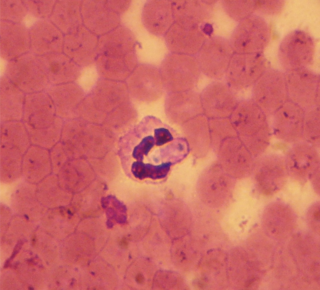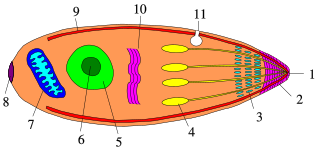Related Research Articles

Hepatozoon is a genus of Apicomplexa alveolates which incorporates over 300 species obligate intraerythrocytic parasites. Species have been described from all groups of tetrapod vertebrates, as well as a wide range of haematophagous arthropods, which serve as both the vectors and definitive hosts of the parasite. By far the most biodiverse and prevalent of all haemogregarines, the genus is distinguished by its unique reciprocal trophic lifecycle which lacks the salivary transmission between hosts commonly associated with other apicomplexans. While particularly prevalent in amphibians and reptiles, the genus is more well known in veterinary circles for causing a tick-borne disease called hepatozoonosis in some mammals.

Leucocytozoon is a genus of parasitic alveolates belonging to the phylum Apicomplexa.
Karyolysus is a genus of coccidia. With the exception of K. sonomae whose vertebrate host is the yellow-legged frog, species in this genus only infect lizards of the genus Lacerta.

Apicomplexans, a group of intracellular parasites, have life cycle stages that allow them to survive the wide variety of environments they are exposed to during their complex life cycle. Each stage in the life cycle of an apicomplexan organism is typified by a cellular variety with a distinct morphology and biochemistry.
The genus Polychromophilus consists of obligate intracellular eukaryotic parasites that infect bats from every continent except Antarctica. They are transmitted by bat flies, which act as an insect vector as well as the parasite’s site of sporogeny. Polychromophilus follows a fairly typical Haemospororidian lifecycle, with gametocytes and gametes restricted to the bloodstream of the host and meronts infecting organs – most notably the lungs and the liver. The type species is Polychromophilus melanipherus, and was described by Dionisi in 1898.
Dactylosoma is a genus of parasitic alveolates of the phylum Apicomplexia.
The genus Schellackia comprises obligate unicellular eukaryotic parasites within the phylum Apicomplexa, and infects numerous species of lizards and amphibians worldwide. Schellackia is transmitted via insect vectors, primarily mites and mosquitoes, which take up the parasite in blood meals. These vectors then subsequently infect reptilian and amphibian which consume the infected insects. The parasites deform erythrocytes of the host into crescents, and can be visualised using a blood smear.
Spirocystis is a genus of parasites in the phylum Apicomplexa. The genus was described in 1911 by Léger and Duboscq.
Chagasella is a genus of parasitic alveolates of the phylum Apicomplexa. Species in this genus infect insects of the order Hemiptera and of the family Termitoidae.
The Archigregarinorida are an order of parasitic alveolates in the phylum Apicomplexa. Species in this order infect marine invertebrates — usually annelids, ascidians, hemichordates and sipunculids.
The Eugregarinorida are the most large and diverse order of gregarines — parasitic protists belonging to the phylum Apicomplexa. Eugregarines are found in marine, freshwater and terrestrial habitats. These species possess large trophozoites that are significantly different in morphology and behavior from the sporozoites. This taxon contains most of the known gregarine species.
The Caulleryellidae are a family of parasites in the phylum Apicomplexa. Species in this family mostly infect dipteran larvae.
The Syncystidae are a family of parasitic alveolates in the phylum Apicomplexa. Species in this family infect insects (Aeshnidae).
The Schizocystidae are a family of parasitic alveolates in the phylum Apicomplexa. Species in this family infect insects.
Caulleryella is a genus of parasitic alveolates of the phylum Apicomplexa. Species in this genus infect insects (Diptera).
Tipulocystis is a genus of parasitic alveolates of the phylum Apicomplexa. Species in this genus infect insects (Diptera).
Mattesia is a genus of parasitic alveolates of the phylum Apicomplexa. Species in this genus infect insects.
Syncystis is a genus of parasitic alveolates in the phylum Apicomplexa.
Schizocystidae is a genus of parasitic alveolates in the phylum Apicomplexa.
Lipocystis is a genus of parasitic alveolates of the phylum Apicomplexa.
References
- ↑ Weiser J (1953) Parasites of the flour beetles Tribolium castaneum. Proc Soc Protozool 4:21